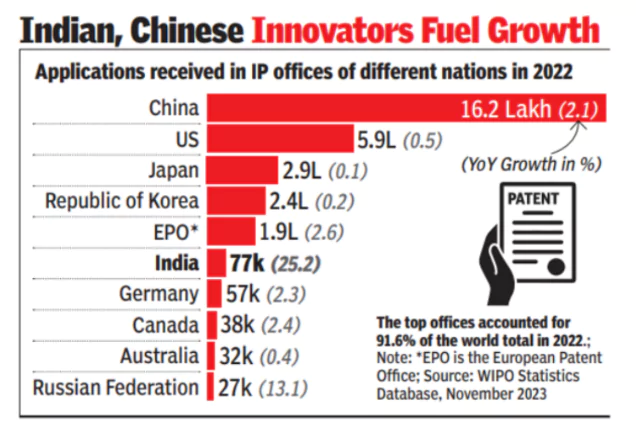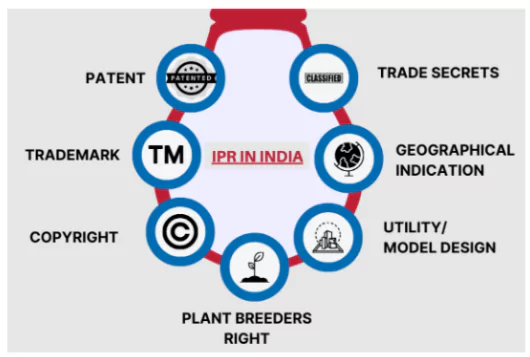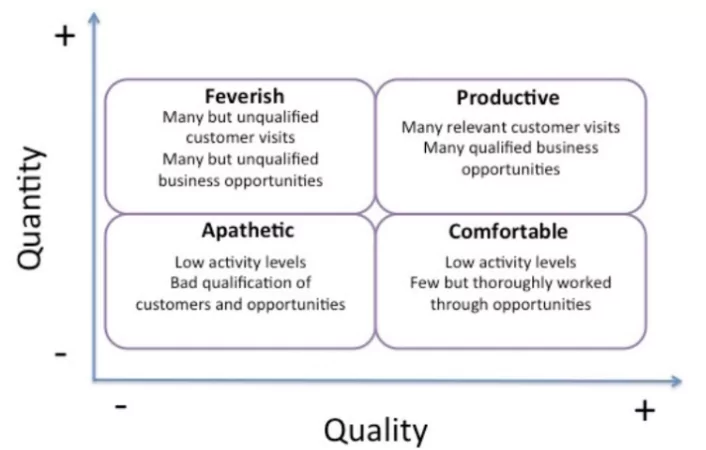Context: In 2022, global patent filling reached new heights, driven by the innovators from India and China propelled by high levels of innovation, entrepreneurship, and digitalization.
More on News:
- Patent Filings by Indian Applicants: According to WIPO’s (World Intellectual Property Organisation) annual World Intellectual Property Indicators (WIPI) report Patent filing grew by 31.6% in 2022.
- Resident Patent Filings: It rose by 47% in 2022 in India with half of the total filings of 77,068 filed with the Indian Patent Office.

-
- For the first time ever, there were more patents filed by Indian residents as against foreign filers, reflecting India’s fast-growing innovation ecosystem.
- Overview of Asia: It accounted for 67.9%, 67.8% and 70.3% of global patent, trademarks and industrial designs filing activity in 2022. The largest rise in filings was reported from India.
- India in Priority Watch List: The “Special 301” Report by USTR is an annual review of the global state of IP protection and enforcement. The USTR report 2023 decided India on its Priority Watch List along with Argentina, Chile, China, Indonesia, Russia, and Venezuela.
About the Indian Patent Regime:
- Patent: It constitutes an exclusive set of rights granted for an invention, whether it be a product or process that introduces a novel approach to accomplishing a task or presents an innovative technical resolution to a challenge.
- Indian Patent Act of 1970: This act governs Indian patents. Under the act, patents are granted if the invention fulfills the following criteria:
- It should be novel.
- It should have inventive step/s or it must be non-obvious.

-
- It should be capable of Industrial application.
- It should not attract the provisions of sections 3 and 4 of the Patents Act 1970.
- Trade-Related Aspects of Intellectual Property Rights (TRIPS): India joined the TRIPS Agreement upon becoming a member of the World Trade Organization (WTO) in 1995.
- Intellectual property can include:
Some of the Salient Features of Indian Patent Act of 1970:
- Both product and process patent provided.
- Term of patent is generally 20 years.
- Both pre-grant and post-grant opposition are allowed.
|
-
- Entrepreneurial ideas.Creations and inventions in Science, Technology, Engineering and Maths (STEM) fields.
- Artistic and literary works.
- IPR-Related Conventions: India is also a signatory to several IPR related conventions, including the Berne Convention, Budapest Treaty, Paris Convention for the Protection of Industrial Property, and Patent Cooperation Treaty (PCT), all of which govern various patent-related matters.
Chinese Patent Experience:
- High Numbers of Patent Filing: According to the WIPO 2023 report, China’s global share of patents has almost doubled, from 24.4% in 2011 to 46.6% in 2021.
- Quantity over Quality: China’s emphasis on innovation resulted in a surge of patents, but a significant portion of them lacked substantial innovation and are often referred to as ‘junk patents.’
- Failure of Incentive Structure: In 2020, China’s National Audit Office revealed that only 8.4% of academic patents were commercially utilized, a notable contrast to the 40-50% rate observed in the United States.
- This is because the state’s policies are focused on direct financial perks, such as subsidies, tax benefits, and social advantages, all tied to patent registration.
|
Reasons for High Patent Filing in India:
- Government Support: The Indian government provides various forms of support viz. patent awareness programs, patent fee discounted etc. to encourage and facilitate patent filing in the country.
- For instance, 22 new TISC (Technology and Innovation Support Centres) have been announced to offer support to individual patent filers, SMEs and start-ups.
- A number of IP facilitators ( IP MITRAs) has been increased from 465 to 2000 under the Scheme for facilitating start-ups Intellectual Property Protection (SIPP).
- India’s Adoption of Emerging Technologies: The surge in number of patent filings underscores India’s standing on the global innovation landscape and its leadership in emerging technologies such as Artificial Intelligence (AI).
- For instance, from the patents filed between FY2010 and FY2022, a substantial 2,66,000 belong to the technology domain and within this patent category, around 160,000 pertain to cutting-edge areas like AI, Internet of Things (IoT), Big Data, Cybersecurity, and Blockchain.
- Efficient Reporting on Patents: India’s move towards IP-driven development will assume more importance in the run-up to 2047 as the country has started releasing the First Examination Reports (FERs) of patents in 4.8 months compared to the time of 6 months taken by many developed nations.
- Startup Culture: Startups, often focused on innovation and disruptive technologies, actively seek to protect their intellectual property through patents.
- Further, startups are being provided 80% fee rebate and fast tracked examination on filing patent applications and 50% fee rebate in filing trademark application.
Challenges Associated with Patent Filing in India:
- Quantity vs Quality: The prevalence of low-quality patents perpetuates a cycle under which patentees are incentivized to continue filing low-quality patents. This trend, termed the “patent paradox” by Gideon Parchomovosky.

-
- Patent paradox suggests that firms engage in high- volume, low-quality patenting strategies to maximize potential benefits from the patent system.
- It’s critical for India to ensure that this does not happen in the country.
- Lack of Efficiency in Granting Patent: India’s lacks the ability to grant patents efficiently. For instance, in 2016-17, India recorded 45,444 patent applications with only 9,847 grants. In 2022-23, although the numbers increased to 82,805 and 34,153 respectively, lack of efficiency reamined a significant challenge.
- Decline in Venture Capital (VC) Funding: Persistent uncertainty remains a burden on the worldwide innovation ecosystem, leading to a decline in VC funding across various regions.
- For instance, as per a GlobalData report, India experienced a 34.6% reduction in VC funding deals compared to 2022, with a total of 920 deals announced from January to October 2023.
- IP protection and Enforcement: In the 2022 report by the U.S. Trade Representative (USTR), India emerged as one of the major economies presenting substantial IP protection and enforcement challenges.
- Issues Raised in the Report: Concerns about what can be patented, waiting times for obtaining patents, reporting requirements, and data safety.
- Gender Disparity: The most concrete measure of the gender gap in intellectual property is assessing women’s engagement in patenting, including their submission of patent applications through the Patent Cooperation Treaty (PCT).
- For example, in India, the share of female inventors who file patent applications between 2019-2021 was 10.2%.
- As of 2023, women globally account for 16.2% of all inventors, with men making up the remaining 83.8%.
Government Activities Under the National IPR Policy:
- Modernisation & Digitisation of IP offices: Improvement in functioning and performance of IP Offices as well as streamlining workflow processes.
- Reduction in filing Fees: For Start-ups, MSMEs, and educational Institutes to encourage Patent filling.
- Expedited Examination: For certain category of applicants, such as Start-ups, small entities, women inventors for expeditious grant of Patents
- National Intellectual Property (IP) Awards: Conferred every year to recognize and reward the top achievers for their IP creations and commercialization.
- Patent Facilitation Programme: It has been revamped to scout patentable inventions and provide full financial, technical and legal support in filing and obtaining patents.
|
Way Forward:
- Lessons from Chinese Patent Approach: The patent office understaffed and underfunded to deal with applications, a problem the government has now fixed. However, as the country progresses in its ability to grant patents efficiently, the focus should now shift towards ensuring that each patent granted represents a genuine and significant innovation.
- Analysis of Patent Quality: India should carry out a post-facto analysis of patent quality, possibly under the aegis of the Office of Principal Scientific Adviser.
- It could assess a patent’s value by the volume of subsequent citations it receives, as a patent tends to accrue more citations if it pioneers a successful technological pathway.
- Saying No to Incentive Structure: Ensure that India does not put an incentive structure in place, especially for educational institutions, that attracts low-quality patents.
- Raising Awareness: To further boost domestic patent filings, partnerships among various stakeholders would be crucial in creating and raising awareness about intellectual property.
- For instance, National IP awareness mission (NIPAM) aims to provide awareness on intellectual property and its rights to 1 million students.
- Central Coordination Body on IP Enforcement: According to the Parliamentary Standing Committee on Commerce’s 161st report on ‘Review of the Intellectual Property Rights Regime in India‘, a central coordination body on ip enforcement can be established for undertaking coordinative efforts in the enforcement and adjudication of IP laws to check IP crimes in the country.
- Introduce Regulation to Protect Artificial Intelligence (AI): It was noted that neither the Indian Patents Act, 1970 nor the Copyright Act, 1957 are well equipped to facilitate inventorship, authorship, and ownership by Artificial Intelligence.
- A separate category of rights for AI and AI-related inventions and solutions should be created for their protection as IPRs.
News Source: Mint
![]() 29 Nov 2023
29 Nov 2023



